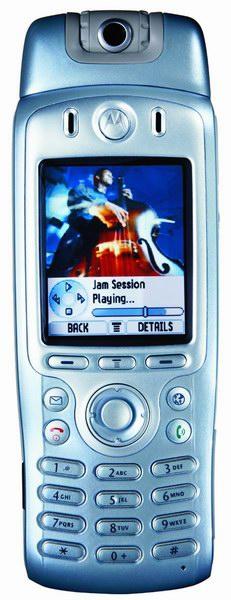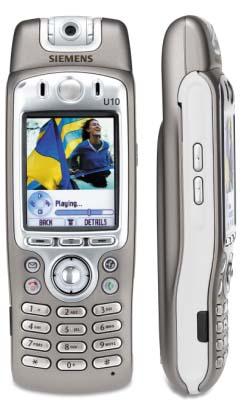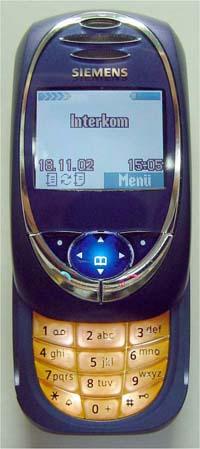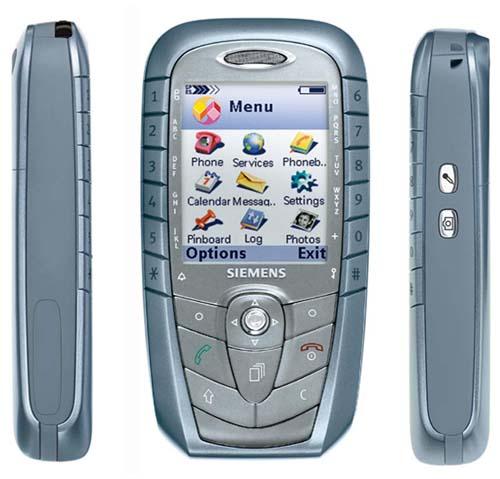
Министерство образования Российской Федерации
Тульский государственный университет
Английский язык
Внеаудиторное чтение
Siemens Mobile – position in the market, analyses of the situation, new models.
Выполнил студент гр. ХХХХХХХ: Ф.И.О.
Преподаватель: Семушкина Т. Л.
Тула 2003
Siemens Mobile – position in the market, analyses of the situation, new models
This year is crucial for Siemens’s mobile business; it would show whether those solutions, which the company made, were right or not. Many things depend on successfulness of new products and the company knows about it. The information concerning new models is too scarce and controversial. We doubt that detail specifications will appear before announcement. We can only assume how these models will be named and what features they will have. This article is only an analysis of various data. It shows our opinion on the current situation. We’ll speak mostly about general tendency of the company and not so much about separate models.
Firstly, let’s remember the history and those, who create phones for Siemens. Today main sales in the middle and high price segments are provided by Siemens S55, SL55, M55. The similarity of these handsets, the fact that they have the same platform, is obvious.
However, the first model based on this platform – Siemens S55, was created due to Microcell and it is an ODM-model. Microcell is a small company. It is difficult for it to maintain many developers, who will create both hardware and software. In reality this company offers solutions based on licensed platforms from Ericsson. In particularly, Siemens S55 is created on the platform of this kind.
A small note about cooperation of Siemens and Ericsson was published in the end 2002 in the corporate newspaper of Ericsson – Contact. It was said that Microcell, which earlier licensed a platform from Ericsson, created a new solution for Siemens.
The same platform is used in such products as Sony Ericsson T68, T68i, T300, T310, T610. All rights for this platform belong to Ericsson. A joint enterprise Sony Ericsson has rights to use this solution. Details of this deal are not known; probably it was done on preferential terms because Sony Ericsson is a subsidiary company for Ericsson. Probably Ericsson took part in these developments too.
So, the situation is the following: all top models from Siemens are based on the platform, which belongs to the other company. Siemens wastes time and loses the race, as Sony Ericsson will have similar models earlier. However, it can offer more adjusted solutions. The announcement sounds logical, but in reality it is not so.
Let’s compare Siemens S55 and Sony Ericsson T68i. These phones are almost the same if compare them by features. They differ in software. Siemens changed it considerably, taking into account own necessities. We don’t know whether it was really necessary; may be it was one of the licensing conditions. But results were profitable. On the contrast to Sony Ericsson T68i Siemens S55 has improved work with MMS-messages. On the other hand, in the first versions of firmware Siemens had problems while working in 1900 MHz band. As a result, many Europeans who traveled to USA couldn’t use roaming. This problem doesn’t exist today.
One of the weaknesses of Siemens S55 is bluetooth realization. In first versions of firmware call transference from the phone to a headset was not comfortably realized. Later it became worse. It shows level of engineers, who face a new function and don’t have experience to work with such kind of products. Till now bluetooth function realization is weak in Siemens S55. Better to say that it is one of the most uncomfortable for using.
So, we can make a conclusion that engineers of the company facing new functions in new products (new platforms) are not always able to provide their fast and right support. Hence, later launching of products does not influence the quality of products. Handsets from Sony Ericsson and Siemens remain comparable. It means that these products mainly compete in prices, not technologies.
Few words about price formation from Siemens. Historically, the company firstly pays attention to products from Nokia and then forms its own offer. Remember opposition of Siemens S35 to Nokia 6210. During the whole life cycle Siemens was 25-35 USD cheaper than Nokia. An earlier launching of S45 made it one of the most popular business phones; delay of Nokia 6310 affects it greatly. It never reached a sales level of Nokia 6210. When Siemens and Nokia had similar product lines it was logically for Siemens to correct prices according to Nokia price policy. Everything was changed, when Nokia introduced a wide product range, which contained much more models. Now it is impossible to compare features of the phones in different price segments. As a result, price formation of Siemens is not always right.
Prices for phones made by Siemens went down faster than prices for Nokia’s handsets. It allows Siemens to support high sales of rather old models, but it demands replacement of these models in the future.
The main problem rises here. It’s not a secret that own new developments are rather expensive. Even such large companies as Siemens understand it. Not long ago Siemens dismissed some employees from several departments, including R&D. It was simpler to reduce costs due to hardware solutions of other companies. Delay in launching could be compensated firstly by original design and secondly – by the product’s price.
Once the company has already used platforms of other manufacturers, for example Siemens U10 – a handset of the third generation. It’s common knowledge that Motorola gave a license to use this platform. When I asked Rudi Lamprecht - Member of the Managing Board at Siemens, why they did it, he answered that they didn’t want to invent something new, they just took the best offer in the market. Siemens U10 has the same design as Motorola A820. The phone has only the other name of the company and color solution. The handsets has similar design as they both are produced at the same plant of Motorola in Germany. It is very convenient for Siemens. ON the one hand the company receives a complete product, on the other – it doesn’t use its own production lines.


Design from Siemens or a new tendency
Now few words about original design from Siemens. To some extent the company promoted pseudo-proof cases (Siemens M35, ME45), later similar handsets could also appear. There is a tendency that design of current models repeats old traditions. For example, Siemens SL55 has the same mode of open (sliding case) as Siemens SL10. Most users of mobile terminals do not remember this model, but it can be compared with Nokia 7650, which has the same system. Siemens assumed that Siemens SL55 would win due to original construction and small dimensions. Now it is not obvious what will be the future of this model, but we think that Siemens overestimated influence of design. They put attraction above phone’s ergonomics. It is not very comfortable to use the phone.

Producing M55, which is almost a cutting copy of Siemens S55 without IrDa and bluetooth, the company also concentrated on design. It is made in youth style: bright colors and blinking indicators. Ergonomics and nice design are combined in this model.
So, the main aim of the company in the near future will be to find new successful designs, which will attract attention of people. For example, they introduced Siemens SX1, which had a pleasant exterior but didn’t allow to input large volumes of information. As a result there is no sense for the targeted group (business users) to buy it. It is moved to a fashion segment, but the price of it is too high for this group. The other group of potential users is so-called Techie, those, who a found of all technical novelties on the market.

Later these design experiments will be widely spread; we’ll see unusual devices, which not always will have good ergonomics.
Once again about price formation and platforms of other companies
We’ve already mentioned that earlier Siemens paid attention to prices of Nokia, and then formed its own price policy. Now it is not so. Licensing one or another platform, Siemens correlates the rates with its price, price of software, warranty service and retail price of other rival products. A small example: there are two similar products in the market (Siemens S55 and Sony Ericsson T68i). What is necessary to do to increase sales of a new model? The right answer is promotion. So, the most influence will have marketing. Novelty plays a positive role but it can’t provide sufficient sales. The phone should be advertised. Besides, novelty (design, brand) allows taking extra money for it and a new phone will be more expensive (Siemens S55 is more expensive than Sony Ericsson T68i). Extra money allows covering advertising costs and warranty service.
It is necessary to understand that choosing of other manufacturers hardware is a right solution, as Siemens has a large market share in Europe. So, producing Siemens S55 the company almost doesn’t compete with Sony Ericsson T68i for the following reasons: both market shares of the companies and appeal of brands are considerably different. A priory Siemens could sale more phones of its trademark than Sony Ericsson, because Siemens has more users and higher brand awareness. Probably these reasons become the strongest while using the platform from Sony Ericsson.
Now let’s view pro and cons of using platforms of other makers and their influence on the end price of the product.
Development of the platform is rather expensive thing and undoubtedly, it is cheaper to buy it. Delay of launching plays negative role, but it can be compensated by different factors, and firstly the company has more freedom in positioning the phone in different price segments. Development of the own software will also demand extra charges.
Warranty service of own platform (better to say products based on own platform) is cheaper. Siemens had platforms, which enabled to repair the phone almost in each situation; very rarely a phone was replaced by another one. In case of using products from Sony Ericsson number of phones which should be replaced is higher.
Besides, if the phone is based on the platform of the other manufacturer and produced as ODM-product on the plant of the other maker, first months problems with components could arise.
Software is not always used all capabilities of the platform. You cannot note it on simple products but surely understand it studying more comprehensive handsets. Developers of software don’t spend time on studying this platform and its capabilities, though they don’t know it initially. As a result, quality of first versions of software is far from ideal. The example, which evidences partly difficulties with software, could be Siemens S55 and postponed launching of Siemens SX1. The company doesn’t change design (not much time is necessary for it). The delay is connected namely with the problems of the phone. Engineers can’t create a perfectly working smartphone during a short period of time, because it is also based on the platform of the other manufacturer.
There are also some more factors, but they play the second role. The main issue is a technological gap. When the company doesn’t develop own platforms, it couldn’t do it at all after some period of time, because it doesn’t have necessary staff. We think that Siemens lost its developers. During several years it has demonstrated elaborations of the future, which are never massively produced (phone-watch, screen combined with a loudspeaker etc.).
Small conclusion
Siemens decided to refuse from own developments of phones. The last own business phone elaborated by this company was Siemens S45. From that time onward the company has used hardware solutions of other manufactures, develops its own software and design. Siemens sells its phones due to high brand awareness and good marketing policy. It’s not bad, but it will be very difficult and too expensive to begin creation of own platforms. The company will depend on suppliers and every year the situation will be worse. Any wrong solution and unsuccessful product will influence position of the company. Today Siemens has nothing except brand and trademark, which it successfully used.
Doubtfully that image of the company will change in the near future. This process will be gradual. However, this year Siemens would lose its market share (both in Europe and Russia).
At last few words about traditions of stags. During two last years (by the first of October) have appeared rumors that Siemens and Motorola are going to create a joint enterprise to produce mobile phones. These rumors have no evidences, but they arouse great interest. We think that this year won’t be an exception and somebody once again will discuss it to for the sake of speculation. Most people have short memory. It means that soon we’ll hear debase about advantages and disadvantages of such unification.
Компания Siemens - положение на рынке, анализ ситуации, новые модели
Для компании Siemens текущий год является переломным для терминального бизнеса, так как именно сейчас будет определяться, насколько проверены решения, принятые ранее. От успешности новых моделей на рынке зависит многое, и в компании это ясно осознают. Информация по новинкам разная, ждать полных и подробных спецификаций до официальных объявлений не следует. Мы можем лишь предполагать с высокой вероятностью, как будут называться модели, и что будут представлять собой. Данный материал ни в коей мере не претендует на истину в последней инстанции, мы лишь проанализировали информацию из различных источников и попытались представить ее в обобщенном виде. Речь пойдет не только и не столько об отдельных аппаратах, сколько об общих тенденциях в компании Siemens.
Для понимания ситуации обратимся к предыстории, точнее к тому, кто создает телефоны для компании Siemens. В настоящий момент основные продажи в среднем и верхнем ценовом сегментах будут обеспечиваться моделями Siemens S55, SL55, M55. Сходство этих аппаратов между собой очевидно и не требуется доказательств того, что в них используется одна и та же платформа.
В то же время, первая модель на этой платформе – Siemens S55 создавалась при непосредственном участии компании Microcell, это ODM-модель ее производства. Для небольшой компании, такой как Microcell, достаточно тяжело содержать большой штат разработчиков, которые способны создавать как аппаратные, так и программные решения. В действительности данная компания предлагает решения, на лицензированных платформах компании Ericsson. В частности, аппарат Siemens S55 создан именно на такой платформе.
Косвенным подтверждением этого служит то, что в корпоративной газете Contact компании Ericsson в конце 2002 года была опубликована заметка о сотрудничестве с Siemens. В материале говорилось о том, что компания Microcell, ранее лицензировавшая платформу Ericsson, создала на ней решение для компании Siemens.
Эта же платформа используется в таких продуктах, как Sony Ericsson T68, T68i, T300, T310, T610. Права на платформу принадлежат именно компании Ericsson, совместное предприятие Sony Ericsson только получило право на ее использование. Детали данной сделки неизвестны, но в этом случае речь идет о льготном лицензировании, ведь компания является для Ericsson дочерней. Вполне возможен факт того, что участие Ericsson, в том числе заключается и в этих разработках.
Итак, складывается интересная ситуация, когда все топ-модели Siemens основаны на чужой аппаратной платформе. Компания проигрывает гонку по времени, так как у Sony Ericsson аналогичные по функциональности модели будут появляться раньше, но может предлагать более выверенные решения. Заявление выглядит логичным, но реальность доказывает обратное.
Обратимся к сравнению Siemens S55 с Sony Ericsson T68i, эти аппараты функционально выглядят как близнецы-братья. Отличия кроются в программном обеспечении, компания Siemens практически целиком изменила его под свои нужды, представив новый продукт. Насколько это было необходимо, подобные шаги вызваны условиями лицензирования, нам, к сожалению, это неизвестно. Но результаты достаточно показательны. Так, в Siemens S55 к лучшему изменены подсказки при работе с MMS-сообщениями, они привязаны к реалиям сегодняшнего дня, в Sony Ericsson T68i они отсутствуют. С другой стороны, в аппарате от Siemens в первых версиях программного обеспечения была плохо организована работа в диапазоне 1900 Мгц, как результат, многие европейцы, попавшие с этим телефоном в США, не смогли воспользоваться роумингом. На данный момент такой проблемы уже не существует.
Слабое место у Siemens S55 - это реализация работы bluetooth, в первых версиях программного обеспечения перевод звонка с телефона на гарнитуру был реализован не самым удобным образом. В последующих версиях он стал еще хуже, это показывает уровень инженеров, столкнувшихся с новой для них функцией и не имеющих опыта работы с подобным продуктом. До настоящего момента реализация bluetooth в Siemens S55 очень слаба, хотя правильнее было бы сказать, что она одна из самых неудобных для пользователя.
Отсюда мы можем сделать единственный вывод, который заключается в том, что инженеры компании, сталкиваясь в новых продуктах (аппаратных платформах) с новыми для них функциями, не всегда способны обеспечить быструю и правильную поддержку. Отталкиваясь от этого утверждения, мы получаем, что более поздний выход продуктов на рынок по сравнению с Sony Ericsson не несет явного плюса в более качественной реализации функций, аппараты остаются сравнимы. Для компании Siemens это означает лишь одно - конкуренция начинается на уровне розничных цен, но не технологий.
Буквально несколько слов о ценах на телефоны от Siemens. Компания в первую очередь ориентируется на продукты от Nokia, принимая их в качестве отправной точки, и далее формирует свое ценовое предложение. Эта ситуация сложилась исторически, можно привести в пример противостояние таких продуктов, как Siemens S35 и Nokia 6210. Телефон от Siemens в течение всего срока жизни был дешевле на 25-35 долларов. Позднее более ранний выход Siemens S45 сделал его наиболее популярным бизнес аппаратом, а вот задержка выхода Nokia 6310 сыграла печальную роль, данная модель так и не догнала по популярности Nokia 6210. Во времена этих продуктов и схожести линеек привязка цен Siemens к стоимости аппаратов Nokia (лидера рынка) была оправданной. Все изменилось, как только компания Nokia представила расширенную линейку, в которую вошло значительно большее число телефонов. Прямое сравнение по функциональности телефонов в одинаковых сегментах стало невозможным, как результат, ценообразование стало оторванным от действительности.
Инертность движения в какой-то мере сыграло положительную роль. Так, динамика изменения цен на телефоны Siemens оставалась высокой, в то время как продукция Nokia дешевела не так быстро. Это позволяло для Siemens поддерживать высокие продажи относительно старых моделей, но и требовало в будущем их замены на новые.
Вот тут и возникла основная проблема, ведь не секрет, что стоимость своих разработок весьма велика, даже такие гиганты, как Siemens не способны не обращать на это внимание. Перед этим компания Siemens провела ряд увольнений, в том числе в исследовательских отделах R&D. Решение напрашивалось само собой, сократить расходы на разработку за счет использования чужих аппаратных решений. Проигрыш по времени выхода продуктов можно было компенсировать несколькими путями, оригинальными дизайнерскими решениями плюс ценой продуктов.
Опыт использования чужих платформ у компании уже был на примере терминалов третьего поколения, в частности, модели Siemens U10. Данная платформа была лицензирована у компании Motorola, это общеизвестный факт. Как сказал председатель правления компании Siemens, Руди Лампрехт, на мой вопрос, по каким причинам это было сделано – «мы не стали изобретать велосипед, а взяли то лучшее, что уже было предложено на рынке». Картину дополняет тот факт, что Siemens U10 имеет те же формы (дизайн), что и Motorola A820, лишь название компании, да цветовое решение иное. Объяснение идентичности дизайна кроется в том, что аппарат производится на германском заводе компании Motorola, компания Siemens лишь осуществляет отгрузки и предпродажную подготовку. Такое решение с позиции компании Siemens идеально, так как она получает не только готовый продукт, но также и не загружает свои производственные линии, которые и так работают на пределе возможностей.
